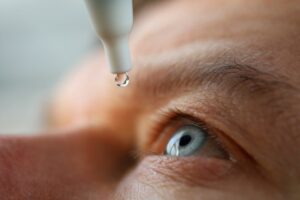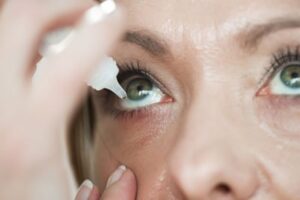Living with diabetes presents a unique set of challenges, and managing dry eyes is one of the lesser-known yet significantly impactful issues many face. Dry eye syndrome is not only uncomfortable but can also exacerbate the complications associated with diabetes, affecting one’s quality of life. This guide aims to shed light on why individuals with diabetes are more susceptible to dry eyes and provides a holistic approach to diabetes dry eyes treatment.
Contents
What Causes Dry Eyes In Diabetes?
 Dry eyes in individuals with diabetes can result from several interconnected factors related to the underlying condition of diabetes itself and its effects on the body. Here are the primary reasons:
Dry eyes in individuals with diabetes can result from several interconnected factors related to the underlying condition of diabetes itself and its effects on the body. Here are the primary reasons:
- High Blood Sugar Levels: Chronic high blood glucose levels can affect the small blood vessels and nerves in the eyes, leading to decreased tear production or tears that evaporate too quickly. This imbalance in the tear film can result in dry eyes.
- Autonomic Neuropathy: Diabetes can cause neuropathy, including autonomic neuropathy, which affects the nerves that control involuntary body functions, including tear production. Damage to these nerves can reduce tear secretion, leading to dryness.
- Inflammation: High blood sugar levels can lead to inflammation throughout the body, including the eyes. This can disrupt the healthy production and maintenance of tears.
- Reduced Blinking: Some individuals with diabetes may experience reduced blinking rates, especially those with retinopathy who may focus intensely during tasks to compensate for vision changes. Reduced blinking fails to adequately spread tears across the surface of the eye, leading to dryness.
- Medications: Certain medications used to treat diabetes and its complications may have side effects that include dry eyes. For example, diuretics used for managing blood pressure can reduce body fluids, including tear production.
- Dehydration: Diabetes can increase the risk of dehydration due to high blood sugar levels and frequent urination. Dehydration can, in turn, lead to dry eyes.
Addressing these underlying factors can significantly improve dry eye symptoms in individuals with diabetes. It’s also important for individuals with diabetes to have regular eye exams to monitor for changes in eye health and receive timely treatment for any complications.
What Are The Best Diabetes Dry Eyes Treatment?
 Treating dry eyes, especially in individuals with diabetes, requires a multi-faceted approach that targets the underlying causes as well as the symptoms. Here are some of the most effective diabetes dry eyes treatment:
Treating dry eyes, especially in individuals with diabetes, requires a multi-faceted approach that targets the underlying causes as well as the symptoms. Here are some of the most effective diabetes dry eyes treatment:
Optimal Diabetes Management
Achieving and maintaining good control over blood glucose levels is foundational in the management of dry eyes for diabetic patients. High blood sugar levels can damage the small blood vessels and nerves in the eye, leading to decreased tear production and dry eye symptoms. Regular monitoring of blood sugar, along with appropriate adjustments to medication, diet, and physical activity, can mitigate these effects.
Punctal Plugs
Punctal plugs are small biocompatible devices inserted into the tear ducts (puncta) to block tear drainage. By keeping tears on the surface of the eye longer, they can significantly alleviate dryness. This procedure is reversible and can be particularly beneficial for those whose tear evaporation or drainage is faster than production.
Eye Ointments
For overnight protection, lubricating eye ointments can be applied to the eyes before sleep. These are thicker than regular eye drops and can help prevent the eyes from drying out overnight. While their viscous nature may cause temporary vision blurriness, this typically isn’t a concern during sleep and provides significant relief for severe dry eye symptoms.
Medication Adjustments
Some medications, including those used to manage diabetes and its complications, can exacerbate dry eye symptoms. Discussing all current medications with a healthcare provider is crucial. Because they may adjust dosages or switch to alternative treatments that have a lesser impact on eye moisture.
Proper Hydration and Nutrition
Hydration plays a key role in managing dry eyes. Drinking plenty of water throughout the day can help, as dehydration worsens dry eye symptoms. Incorporating foods high in omega-3 fatty acids into the diet can also support eye health by improving the quality of the eye’s tear film.
Environmental and Lifestyle Changes
Adjusting the living and working environment can provide significant relief. Using a humidifier, especially in dry climates or heated indoor spaces, can increase air moisture levels. Protecting the eyes from wind, smoke, and air conditioning with glasses or sunglasses can also prevent tear evaporation. Regular eye rest and blinking exercises, especially during prolonged screen use, can improve tear distribution and reduce eye strain.
Specialty Eyewear
Specialty glasses and goggles create a moisture-retaining seal around the eyes, which can be particularly helpful in harsh or dry environments. These are designed to minimize tear evaporation, providing relief for individuals with severe dry eye symptoms.
Managing Blepharitis
Blepharitis, a common eyelid inflammation, can contribute to dry eye symptoms by affecting tear quality and eye surface health. Managing blepharitis through good eyelid hygiene, such as using warm compresses and eyelid scrubs, can alleviate discomfort and improve tear function.
Regular Eye Exams
For those with diabetes, regular eye exams are crucial, not only for monitoring and managing dry eye syndrome but also for detecting and treating other potential eye complications early. An eye care professional can offer personalized advice and adjustments to dry eye treatments as needed.
Advanced Treatments
In severe cases where conventional treatments are insufficient, advanced options like autologous serum eye drops—created from a patient’s blood—can be effective. These drops have components similar to natural tears and can provide significant relief. Additionally, scleral lenses, which cover the entire corneal surface to maintain a hydrating tear reservoir, may be recommended for intensive moisture retention.
A comprehensive approach, combining these strategies under the guidance of healthcare professionals, can significantly improve comfort and eye health for individuals with diabetes experiencing dry eye syndrome.
What Eye Drops Are Good For Diabetes?
 For individuals with diabetes, especially those experiencing dry eye syndrome, the choice of eye drops needs to be carefully considered to both alleviate symptoms and avoid exacerbating underlying conditions. Here are the types of eye drops used in diabetes dry eyes treatment:
For individuals with diabetes, especially those experiencing dry eye syndrome, the choice of eye drops needs to be carefully considered to both alleviate symptoms and avoid exacerbating underlying conditions. Here are the types of eye drops used in diabetes dry eyes treatment:
Artificial Tears
Artificial tear drops are the most commonly recommended first line of treatment for dry eyes. They help to lubricate the eye, reduce discomfort, and provide temporary relief from dryness. For those with diabetes, it’s advisable to use preservative-free formulas, especially if the drops need to be applied more than four times a day, to avoid potential irritation from preservatives.
Anti-inflammatory Eye Drops
- Cyclosporine (Restasis): A prescription eye drop that helps increase tear production and reduce inflammation associated with dry eye syndrome. It’s beneficial for long-term use.
- Lifitegrast (Xiidra): Also a prescription option, it targets inflammation and can improve tear production. Both Restasis and Xiidra are suitable for people with diabetes under medical supervision.
Steroid Eye Drops
Short-term use of mild steroid eye drops may be prescribed by a doctor to quickly reduce inflammation. However, due to potential side effects like increased intraocular pressure and risk of infection, they must be used under strict medical guidance, especially in diabetics who are at higher risk for eye complications.
Autologous Serum Eye Drops
In severe cases, especially when standard treatments don’t provide relief, eye drops made from a person’s blood serum can be used. These are custom-prepared and contain natural growth factors and vitamins that help heal the eye’s surface. They are particularly useful for those with severe dry eye symptoms, including individuals with diabetes, but require special preparation by a medical facility.
Lubricating Eye Ointments
For nighttime use, lubricating eye ointments can be recommended to prevent dryness while sleeping. These are thicker than eye drops and can help keep the eyes moist overnight. They are generally safe for people with diabetes but should be used as directed by a healthcare professional.
Individuals with diabetes need to consult with their healthcare provider before starting any new eye drop or treatment. This will help to ensure it’s appropriate for their specific health needs and to avoid any potential interactions or side effects.
Conclusion
Diabetes dry eyes treatment requires a thoughtful blend of lifestyle adjustments, diligent diabetes control, and targeted treatments. From utilizing lubricating eye drops and embracing nutritional changes to maintaining optimal hydration and undergoing regular eye exams, there are numerous paths to relief and comfort. The key is to stay informed, work closely with healthcare professionals, and adopt a proactive approach.
With the right strategies and support, individuals with diabetes can effectively manage dry eye symptoms, ensuring better eye health and improving their overall quality of life. Do you want to get rid of diabetes? Join our online diabetes treatment program and reverse Diabetes naturally through lifestyle changes such as a Personalized Diet plan, Exercise, Yoga, dieticians, and health coaches.

